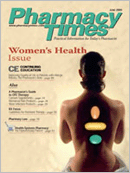Publication
Article
Pharmacy Times
Addressing the Pharmacist Shortage
Author(s):
The Pharmacy Manpower Project has concluded thatthe supply of pharmacists will not meet the need bythe year 2020. An estimated 417,000 pharmacists willbe required to fill a variety of positions, whereas only260,000 will be supplied by our nation's pharmacy schools.1
In an effort to be part of the solution to the problem,Duquesne University, Mylan School of Pharmacy, in Pittsburgh,Pa, has developed a Pharmacist Refresher Program.This program was designed for pharmacists who have beenraising children; working in administration, sales, or academia;or simply not practicing. Many such pharmacists maywant to reenter pharmacy practice but may be intimidatedbecause of all the changes that have taken place over theyears. Other pharmacists have said that they have a need forsuch a program to give them the information, education,and confidence to practice again.
The goal of the program is to reinforce and enhance participants'pharmacy background and to afford them theopportunity to apply it to current pharmacy practicethrough lectures and workshops. Learning objectives areprovided for each topic, along with extensive handouts. Participantsalso are invited to attend the NAPLEX Review Programthat is offered to graduating pharmacy students.
The Pharmacist Refresher Program is a 10-week comprehensiveprogram, with sessions conducted once weekly. It isoffered in the evening because some participants are working,although not in the pharmacy field. Others have childcare considerations.
Topics include New Drug Updates and Regimens, Reviewof Advances in Medication Distribution System Technologyand Software, OTCs and Self-Care, Herbal and NutriceuticalProducts, Clinical Skills, Pharmacy Calculations, and Pharmacokineticsand Biopharmaceutics. Also covered are Third-Party Reimbursement Issues, Employee and Inventory Management,Drug Information Resources, ProfessionalCommunications, Pharmacy Law, and Medication Errors.
A comprehensive review of the new drugs and drug classesin the last 15 years is given, with attention also paid toemerging topics and treatments that are on the horizon.Because a vast majority of employers are utilizing automationand technology to improve workflow and decreasemedication errors, participants are exposed to state-of-theartequipment and software. Participants get to experiencethis technology firsthand in the Duquesne University Centerfor Pharmacy Practice.
Studies have shown that 73% of Americans would ratherself-treat than visit a physician.2 Patients may not want towait in a physician's office; some may not have insuranceand may not be able to afford to see a physician. In the year2000, $21 billion was spent on nonprescription medicationsand at least $11.3 billion on herbal products.3,4 Therefore,the use of OTC medications, herbal products, and nutriceuticalsis covered in the program in depth.
A brief review of pharmacy calculationsis presented. Laboratory testsand other monitoring parametersare discussed. A major concern ofthe participants has been interactionwith insurance companies and howto handle the many issues pharmacistsface every day with third-partyagents. This topic is discussed ingreat detail.
Although it is known thatautomation and technology help todecrease medication errors, one ofthe sessions is devoted to how pharmacistscan decrease the chance ofthese errors occurring in their ownpractice environment. Current druginformation resources are presented,and a demonstration of personaldigital assistants lets the participantsknow what information is availableto assist them and how to accesssuch programs.
The final session of the programincludes a hands-on workshopallowing participants to work withthe most current, state-of-the-artautomation and technology. At thisstage, they should be able to completethe entire prescription-fillingprocess, from entering informationinto the computer, to evaluatinginteractions and alerts, to filling theprescription. The most recent participantsreported that this one particularsession made them feel thatthey could enter pharmacy practiceagain with confidence.
By the end of the program, participantsgenerally have a good ideaof what practice setting they wantto pursue. The program includes asession on employment opportunities,with local community pharmacyand hospital recruiters featured.
A certificate of completion isawarded to each participant who fulfillsthe program requirements. Continuingeducation credit also isawarded for several sessions of theprogram individually or as a whole.
Suggestions for future offerings inthe program have been given. Participantswant to focus on new drugcategories, such as angiotensin-receptorblockers, rather than onspecific disease-state approaches.Disease states have not changed, buttreatment options have. More informationon herbal products isdesired. Common uses, drug interactionswith prescription and nonprescriptionmedications, and managementof adverse effects are a fewother areas that need more emphasis.Participants also have said thatproviding an experiential site at anoperational pharmacy at the end ofthe program would be an enhancement.
The authors are now developingan on-line Pharmacist Refresher Program.It is expected to be available inthe late fall of this year.
Dr. McFalls-Stringert is director of the Center for Pharmacy Practiceand an instructor of pharmacy practice at Duquesne University,Mylan School of Pharmacy. Dr. Mattei is division head of clinical,social, and administrative sciences and an associate professor ofpharmacy practice. Dr. Vanderveen is dean of the Mylan School ofPharmacy and of the Graduate School of Pharmaceutical Sciences anda professor of pharmacy practice.
For a list of references, send a stamped,self-addressed envelope to: ReferencesDepartment, Attn. A. Stahl, PharmacyTimes, 241 Forsgate Drive, Jamesburg, NJ08831; or send an e-mail request to:astahl@ascendmedia.com.







